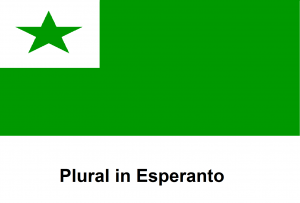Difference between revisions of "Language/Esperanto/Grammar/Plural"
Jump to navigation
Jump to search
m (Quick edit) |
m (Quick edit) |
||
| Line 1: | Line 1: | ||
[[File:Plural in Esperanto.png|alt=Plural in Esperanto|thumb|Plural in Esperanto]] | [[File:Plural in Esperanto.png|alt=Plural in Esperanto|thumb|Plural in Esperanto]] | ||
Hello everybody, | Hello everybody, | ||
| Line 8: | Line 7: | ||
Feel free to edit this page by adding new words and expressions ! | Feel free to edit this page by adding new words and expressions ! | ||
Happy learning ! :) | |||
Once you've covered this material thoroughly, you may be interested in pursuing these associated lessons: [[Language/Esperanto/Grammar/Gender|Gender]], [[Language/Esperanto/Grammar/Negation|Negation]], [[Language/Esperanto/Grammar/Nouns|Nouns]] & [[Language/Esperanto/Grammar/Past-Participle-in-Esperanto|Past Participle in Esperanto]]. | |||
== '''Some examples for Plural in Esperanto''' == | == '''Some examples for Plural in Esperanto''' == | ||
{| class="wikitable sortable" | {| class="wikitable sortable" | ||
| Line 116: | Line 114: | ||
<youtube>VU1OyIW4WNo</youtube> | <youtube>VU1OyIW4WNo</youtube> | ||
== | ==Other Lessons== | ||
* [[Language/Esperanto/Grammar/Future-Tense|Future Tense]] | * [[Language/Esperanto/Grammar/Future-Tense|Future Tense]] | ||
* [[Language/Esperanto/Grammar/Past-Participle-in-Esperanto|Past Participle in Esperanto]] | * [[Language/Esperanto/Grammar/Past-Participle-in-Esperanto|Past Participle in Esperanto]] | ||
| Line 126: | Line 124: | ||
* [[Language/Esperanto/Grammar/Adverb|Adverb]] | * [[Language/Esperanto/Grammar/Adverb|Adverb]] | ||
* [[Language/Esperanto/Grammar/Word-Order|Word Order]] | * [[Language/Esperanto/Grammar/Word-Order|Word Order]] | ||
<span links></span> | |||
Latest revision as of 17:26, 26 March 2023
Hello everybody,
In today's lesson you will learn some useful vocabulary about ¨PLURAL¨ in Esperanto.
Feel free to edit this page by adding new words and expressions !
Happy learning ! :)
Once you've covered this material thoroughly, you may be interested in pursuing these associated lessons: Gender, Negation, Nouns & Past Participle in Esperanto.
Some examples for Plural in Esperanto[edit | edit source]
| ENGLISH | PRONUNCIATION
ENGLISH |
ESPERANTO | PRONUNCIATION
BRAZILIAN PORTUGUESE |
BRAZILIAN
PORTUGUESE |
|---|---|---|---|---|
| The house | doh moy | Domoj | do moi | A casa |
| The cat | kah toy | Katoj | ka toi | O gato |
| The dog | Hoon doy | Hundoj | Hun doi | O cachorro |
| The friend | ah mih koy | Amikoj | a mi koi | O amigo |
| easy | fah tsi lah ih | Facilaj | fa tsi lai | fácil |
| african | ah frih kah ih | Afrikaj | a fri kai | africano |
| beautiful | beh lah ih | Belaj | be lai | belo |
| clean | pou rah ih | Puraj | pu rai | limpo |
Esperanto plural[edit | edit source]
In Esperanto we fom plural by adding "j" at the end of nouns and adjectives as you can see in the following table :
| Singular form | Plural form |
|---|---|
| Domo (house) | Domoj |
| Kato (cat) | katoj |
| Hundo (dog) | Hundoj |
| Amiko (friend) | Amikoj |
| Facila (easy) | Facilaj |
| Afrika (african) | Afrikaj |
| Bela (beautiful) | Belaj |
| Pura (clean) | Puraj |
Video lesson[edit | edit source]
Other Lessons[edit | edit source]
- Future Tense
- Past Participle in Esperanto
- WORD BUILDING
- THE ACCUSATIVE
- Comaratives and Superlatives
- Nouns
- Past Tense
- Adverb
- Word Order
